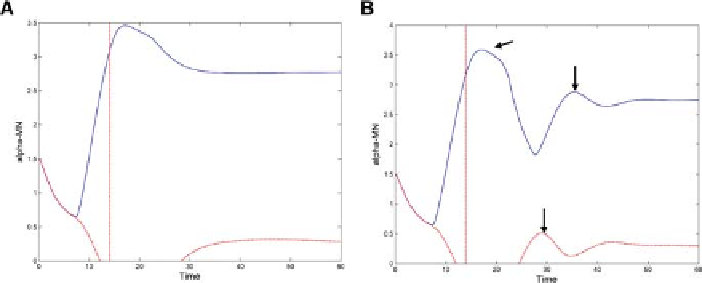Information Technology Reference
In-Depth Information
where
F
i
was the feedback activity of force-sensitive Golgi tendon organs.
While the extended model was successful in simulating the neuronal activity
of the reciprocal and bidirectional cells and proposed for the functional roles in
joint movement and stiffness, it failed to simulate the second agonist burst of both
the reciprocal and the bidirectional neurons (see columns 1 and 3 of figures 10.2
and 10.3). Due to this failure a biphasic (not triphasic) pattern of
-motorneuronal
activation is produced (see Fig. 10.4A). As mentioned earlier, the role of the second
agonist burst of the triphasic pattern is to clamp the limb to its final position [29].
To simulate the second observed burst in the reciprocal and bidirectional dis-
charge patterns as well as in the
α
-MN activities, the extended VITE-FLETE model
of Fig.10.1a [15, 16, 18] was further extended (see Fig. 10.1B) by incorporating the
effect of the neuroanatomically observed muscle spindle feedback to the cortex [17].
To model this effect, equation (10.2) was changed to
α
dV
i
dt
=
30
(
−
V
i
+
T
i
−
A
i
+
a
w
·
(
W
i
(
t
−
τ
)
−
W
j
(
t
−
τ
)))
,
(10.9)
where
T
i
was the target position command,
A
i
was the current limb position com-
mand,
a
w
was the gain of spindle feedback, and
W
i
,
j
were the spindle feedback
signals from the antagonist muscles. A clear triphasic AG
1
-ANT
1
-AG
2
reciprocal
pattern of cellular activity is evident in figure (column 1 of figure 10.3). Similarly,
the activity of bidirectional neurons tuned to both directions of movement is also
shown (column 3 of figure 10.3). The simulated marked by an arrow first peak of
extension and second peak of flexion reciprocal cells is primarily due to spindle
feedback input to DV activity (a feature lacking in [18]). This cortical triphasic pat-
tern of neuronal activation then drives the antagonist
-MNs and produces at their
level a similar triphasic pattern of muscle activation (see Fig. 10.4B).
α
Fig. 10.4: (A) Simulated
-MN activity when the muscle spindle feedback is absent
from the cortex. Note a pronounced biphasic AG1-ANT1 pattern of muscle acti-
vation. The second AG2 bursts are absent. (B) Simulated
α
-MN activity when the
muscle spindle feedback is present in the cortex. Note a clear triphasic AG1-ANT1-
AG2 pattern of muscle activation.
α

